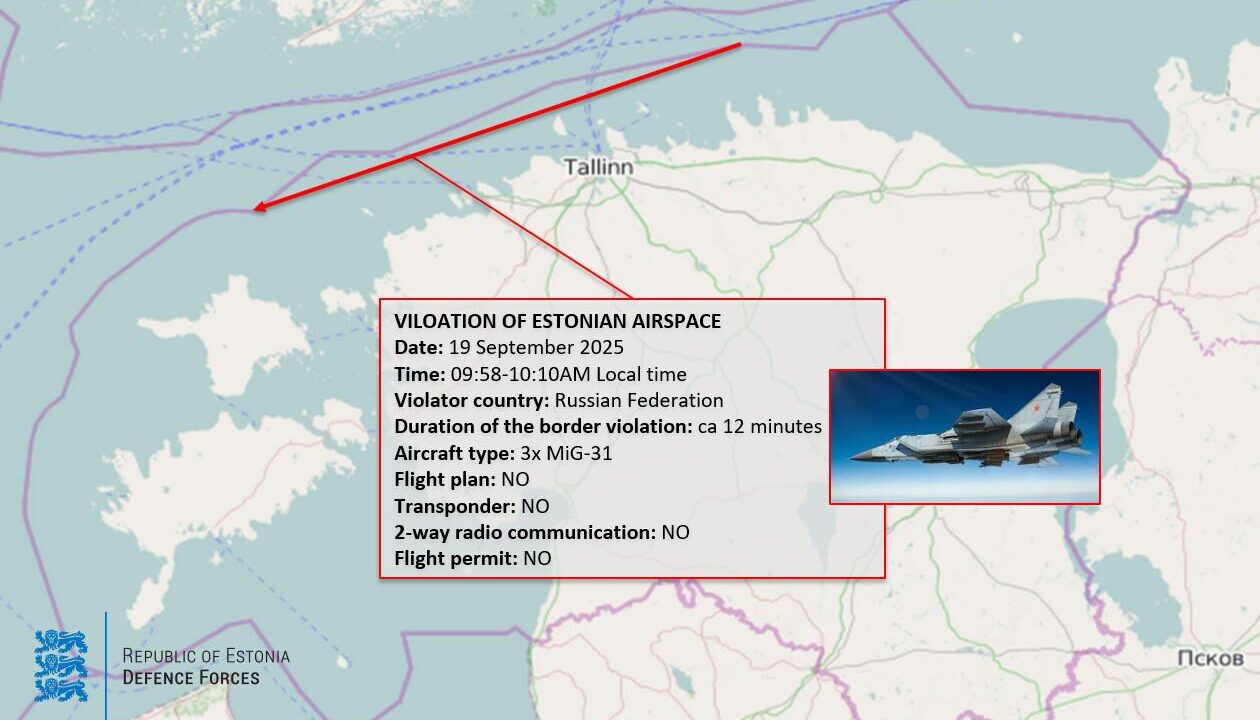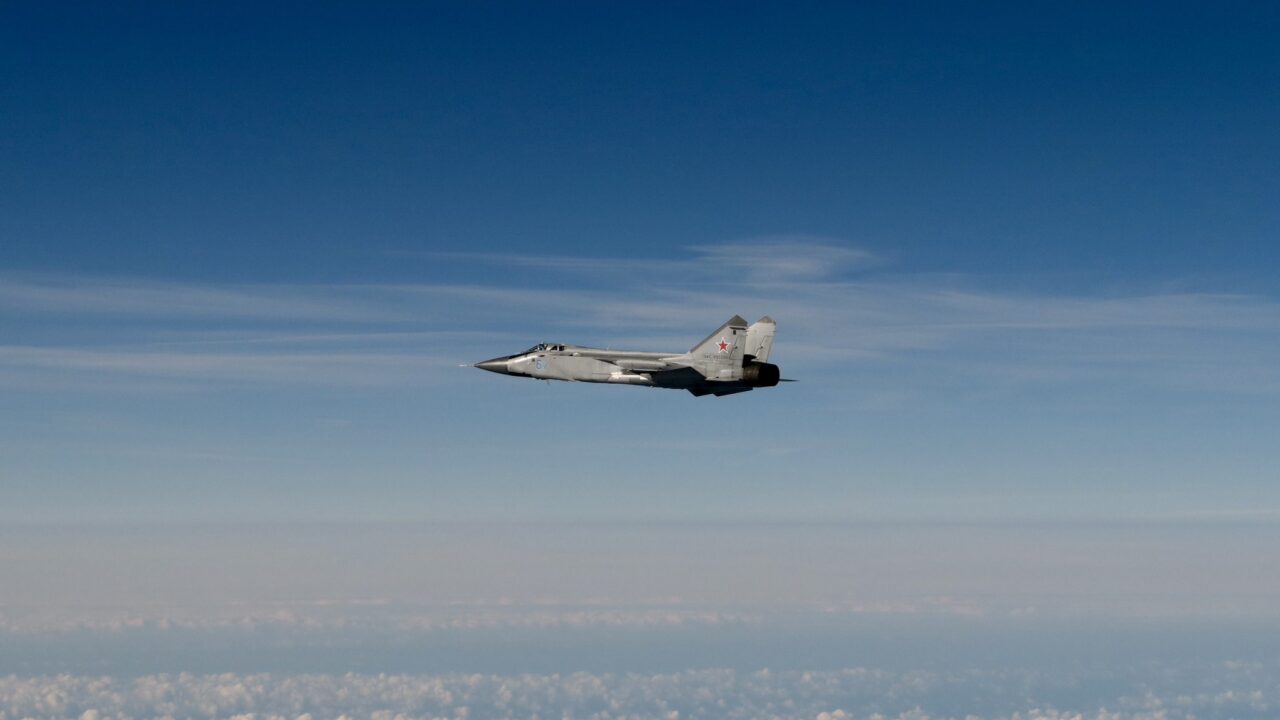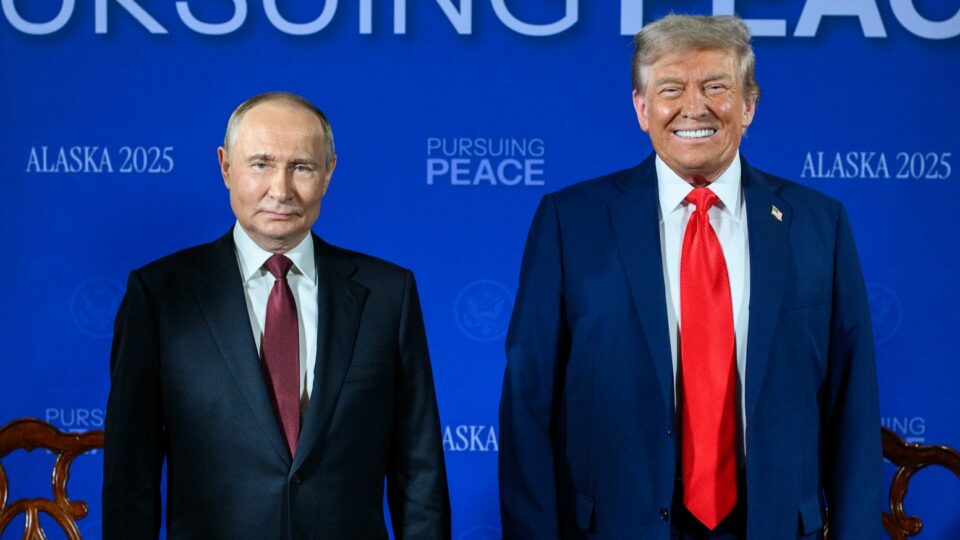On September 19 of this year, three Russian MIG-31 fighter jets unlawfully entered Estonian airspace near the island of Vaindloo, penetrating nearly 10 kilometers deep and remaining there for approximately 12 minutes while flying parallel to the Estonian state border from east to west. The fact that the aircraft had no flight plans, no bilateral radio contact with Estonian air traffic control, and their transponders were switched off strongly indicates that this was a deliberate provocation. The aim was likely to test how the Estonian state and NATO’s air policing mission would respond to such a border violation.
This was already the fourth airspace violation by Russian aircraft in 2025. On September 7, a Russian MI-8 helicopter similarly entered Estonian airspace without authorization in the same Vaindloo area and remained there for about four minutes. A recent study by the International Institute for Strategic Studies revealed that confirmed Russian hybrid attacks on European critical infrastructure increased by 246% between 2023 and 2024. A significant portion of these incidents involved violations of maritime and air borders.
Most of the Russian incursions into Estonian airspace have occurred in the vicinity of Vaindloo Island, with dozens of such cases recorded over the past two decades. The maritime and air borders between Estonia and Russia are based on administrative boundaries established during the Soviet era, which do not always provide logical delineations and create sensitive and potentially conflict-prone situations.
The border treaty would have eliminated the inconsistencies
Due to the Soviet-era airspace structure, the St. Petersburg Flight Information Region (FIR) and the Tallinn FIR do not align with national borders, and part of Estonian airspace near Vaindloo still falls under the St. Petersburg FIR. A similar example on the land border is the so-called Saatse Boot in southeastern Estonia, where access to the Estonian territory of Saatse has, for decades, required crossing a sliver of Russian Federation territory.
The border treaty between Estonia and Russia would have eliminated these inconsistencies, but the unresolved status allows the Russian Federation to carry out various provocative actions and initiate hybrid attacks that increase regional tensions. Since the latest border violation lasted for an extended period and disregarded safe air traffic regulations, it is likely that the act was deliberate, aimed at testing NATO’s response capability.
Cooperation between NATO’s air policing mission and the Estonian Air Force kept the situation under control on September 19. Radars detected the Russian aircraft, which were first intercepted by Finnish jets. Once in Estonian airspace, Italian fighter jets on duty took over, directing the intruders out of Estonian airspace and escorting them all the way to their final destination in Kaliningrad.
This latest action drew broader international attention, with the matter discussed in the United Nations Security Council. Estonia, invoking Article 4 of the NATO Charter, called for consultations among NATO member states to address the situation.
Initiating consultations indicates that this incident is of strategic importance. Recent drone incidents in Poland, Denmark, and Norway have also raised calls for stronger airspace protection. All of these cases have led to consultations among EU countries with the aim of creating a drone wall along the eastern border.
The airspace controlled by a country is defined by its land and maritime borders – that is, the territory located above the areas delineated by these borders. Definitions originating in maritime law also apply to airspace. Airspace beyond national borders is considered international, similar to the concept of “international waters” in maritime law.
There is no universally accepted international agreement that clearly defines the upper limit of sovereign airspace – that is, the boundary between national airspace and outer space. However, according to international practice, this boundary lies somewhere between 30 km (the maximum altitude of aircraft and balloons) and 160 km (the lowest stable short-term Earth orbit). Airspace is further divided into different zones, some of which are controlled by air traffic services and others not.
The border treaty between Estonia and Russia would have eliminated these inconsistencies, but the unresolved status allows the Russian Federation to carry out various provocative actions and initiate hybrid attacks that increase regional tensions.

Three Russian fighter jets violated Estonian airspace. Photo: Swedish Air Force
The border issue as a political game serves Moscow’s interests
The border issue has been a sensitive topic for the Estonian public, as political narratives popular among some parties are reluctant to acknowledge the reality that emerged after World War II. Cloaked references to territorial claims can generate additional votes for populist parties during elections. In practice, calls proclaiming the border treaty unnecessary serve the strategic goals of the Russian Federation.
According to the Constitution of the Republic of Estonia (§ 122) and the State Border Act (§2, clauses 2–3), Estonia’s land border is defined by the Treaty of Tartu signed on February 2, 1920, and other inter-state border agreements, while the country’s maritime and air borders are established based on international conventions. Although Article III of the Treaty of Tartu defined the land border between Estonia and Russia, it left the air and maritime borders unregulated.
On August 15, 1944, the Soviet central government incorporated most of the Petseri County, including the town of Petseri, into the territory of the Russian SFSR. In 1945, the areas beyond the Narva River were also annexed to the Russian SFSR. In 1995, Estonia formally renounced territorial claims to areas that had previously belonged to the Republic of Estonia. On May 18, 2005, the foreign ministers of Estonia and Russia signed a border treaty in Moscow, but on June 20, 2005, the Estonian Parliament added a preamble referencing the Treaty of Tartu to the treaty’s ratification act. The Russian Federation interpreted this as a breach of the agreement and withdrew its signature.
The border treaty was re-signed in 2014, but it has remained unratified due to Russia’s aggression against Ukraine. Looking at Estonia’s neighbors, the Lithuania–Russia border treaty entered into force in 2003, and the Latvia–Russia treaty in 2007.
The Russian Federation, as the legal successor of the Soviet Union, has to this day not recognized the validity of the Treaty of Tartu or the 1920-defined Estonia–Russia border. Since the Treaty of Tartu is not a border treaty in its essence but was intended to end hostilities between the Republic of Estonia and Soviet Russia, invoking it in today’s political context has politicized the border issue and hindered the resolution of several important inter-state matters.
Since the Soviet Union annexed the Republic of Estonia, the political map of Europe has changed significantly, and current best practice dictates that borders should be changed only through bilateral agreements. It is the Russian Federation that has most egregiously violated these principles – in 2014, it annexed Crimea, which was part of Ukraine, including the separately mentioned region of Sevastopol, and in 2022, it unilaterally incorporated the Kherson, Zaporizhzhia, Luhansk, and Donetsk regions into its territory, including areas that remain under Ukrainian control to this day.
In practice, calls proclaiming the border treaty unnecessary serve the strategic goals of the Russian Federation.

The so-called Saatse Boot in southeastern Estonia, where access to the Estonian territory of Saatse has, for decades, taken place through Russian Federation territory. Photo: Kersti Virro
Myths don’t protect the border
In the narratives promoted by some of our politicians, there is occasionally the notion that Russia’s violation of legal norms somehow grants us the right to respond in kind. This is a deeply flawed understanding that in reality attempts to undermine the validity of international norms. It is in Estonia’s interest to participate in a political and legal system based on the principles of international law and to treat violations of those norms as unlawful acts.
In July of this year, I published an article with U.S. scholar Eric Shiraev in The National Interest titled “Decoding Vladimir Putin’s Baltic Strategy,” which, among other things, put forward the hypothesis that the failure to conclude the border treaty in 2005 may have been the result of Russian influence operations. Russia’s political objective has always been to create “frozen conflicts” in former Soviet territories in order to maintain instability and enable intervention when needed. Such unresolved conflict zones have emerged in Transnistria to influence Moldova, in Abkhazia and South Ossetia to pressure Georgia, and in Nagorno-Karabakh to affect Armenia and Azerbaijan.
Estonian political circles have long underestimated the need to regulate legal relations with an unstable eastern neighbor, and this has left noticeable gaps in our national security. As a result, we are still debating whether our eastern border is sufficiently secure, even though the 2014 Eston Kohver incident exposed the vulnerability of our border and the need for tighter control.
If the Republic of Estonia continues to favor legal ambiguity over formally codified documents – in the hope of gaining advantage from such a situation in the future – we are essentially adopting the same principles that guide the Russian Federation’s border practices. We have had to accept the disappearance of border markers in the Narva River and repeated airspace violations because fixing the border with Russia’s current authorities has not been considered a priority.
Our foreign policy practice appears to be influenced by national mythology, leading to the irrational preference for Vladimir Lenin’s historic signature on the Treaty of Tartu over President Vladimir Putin’s signature on a modern border treaty. By appealing to the reintegration of the Petseri region and territories beyond the Narva River – a topic that is not used in official political discourse but is often invoked at the party level for short-term political gain – we are following patterns of behavior similar to those used by Russia to justify its annexation of Ukrainian territories.
It is in Estonia’s interest to participate in a political and legal system based on the principles of international law and to treat violations of those norms as unlawful acts.




